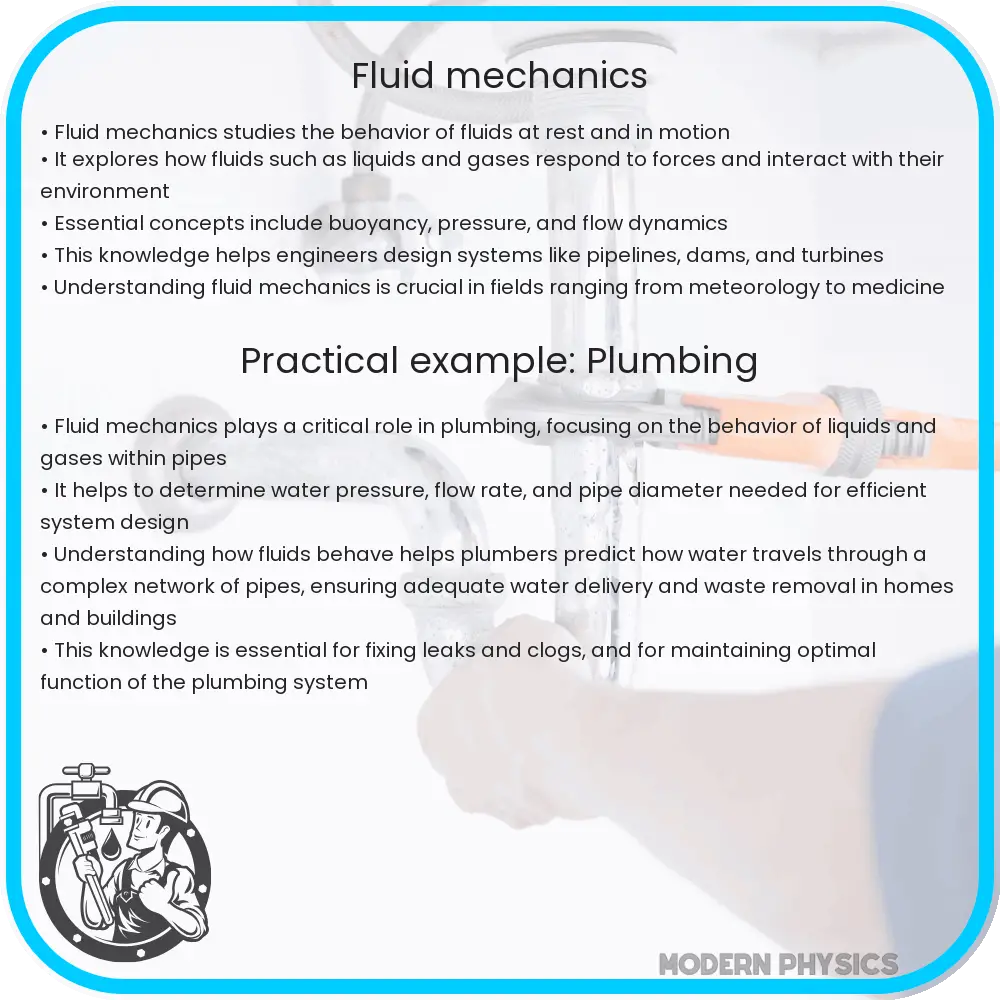Explore the essentials of fluid mechanics, covering principles, dynamics, applications in engineering, aerospace, and CFD in this comprehensive guide.

Understanding Fluid Mechanics: Principles and Dynamics
Fluid Mechanics, a fundamental branch of physics and engineering, plays a crucial role in understanding the behavior of fluids under various conditions. It is integral in a wide range of applications, from designing complex piping systems to predicting weather patterns. This article delves into the core principles of fluid mechanics, its applications, and the dynamics of fluid movement.
Core Principles of Fluid Mechanics
At the heart of fluid mechanics lie several key principles:
- Continuity Principle: This principle states that the mass of fluid entering a system is equal to the mass exiting it. Mathematically, it’s expressed as \( A_1V_1 = A_2V_2 \), where \( A \) represents cross-sectional area and \( V \) represents velocity.
- Bernoulli’s Equation: Bernoulli’s principle is fundamental in fluid dynamics, expressing the conservation of energy in a flowing fluid. It is written as \( P + \frac{1}{2}\rho V^2 + \rho gh = \text{constant} \), where \( P \) is pressure, \( \rho \) is density, \( V \) is velocity, and \( h \) is the height above a reference point.
- Navier-Stokes Equations: These complex equations describe how the velocity field of a fluid flows. They are crucial in simulating fluid flow in various scenarios.
Applications of Fluid Mechanics
Fluid mechanics finds applications in numerous fields:
- Engineering: In mechanical and civil engineering, fluid mechanics is essential for designing systems like HVAC, water supply, and sewage systems.
- Aerospace: Understanding the flow of air over aircraft surfaces is vital for designing efficient and safe airplanes.
- Medical Science: Fluid mechanics principles are used in understanding blood flow in the human body, crucial for medical diagnoses and treatments.
Dynamics of Fluid Flow
The dynamics of fluid flow can be broadly categorized into two types:
- Laminar Flow: In laminar flow, fluid particles move in parallel layers with no disruption between them. This type of flow is characterized by smooth, orderly motion.
- Turbulent Flow: Turbulent flow is chaotic and characterized by eddies and vortices. It occurs at high velocities and in rough surfaces.
Understanding these flow types is crucial for designing efficient systems in various engineering disciplines.
Fluid mechanics also explores concepts like viscosity, which is the measure of a fluid’s resistance to flow, and the Reynolds number, a dimensionless quantity used to predict flow patterns in different fluid flow situations.
Advanced Concepts in Fluid Mechanics
Beyond basic principles, fluid mechanics encompasses several advanced concepts that are vital for specialized applications:
- Compressible vs Incompressible Flow: Fluids like gases can be compressible, meaning their density changes under pressure variations. In contrast, liquids are largely incompressible.
- Viscous Flow: Viscosity plays a significant role in determining fluid flow characteristics. High viscosity fluids, like oil, flow slower than low viscosity fluids, like water.
- Boundary Layer Theory: This theory explains the behavior of fluid flow near a solid boundary, essential in aerodynamics and hydrodynamics.
Computational Fluid Dynamics (CFD)
One of the most significant advancements in fluid mechanics is Computational Fluid Dynamics (CFD). CFD uses numerical analysis and algorithms to solve and analyze problems involving fluid flows, drastically enhancing the ability to predict and visualize fluid behavior in complex systems.
Environmental and Geophysical Fluid Dynamics
Fluid mechanics also plays a crucial role in environmental and geophysical sciences. Understanding ocean currents, atmospheric dynamics, and even the movement of glaciers involves fluid dynamics principles.
Challenges and Future Directions
Despite its advancements, fluid mechanics faces challenges like accurately modeling turbulent flows and understanding the microscale fluid behaviors. The future of fluid mechanics is geared towards more accurate simulations, sustainable energy solutions (like wind and hydro turbines), and biomedical applications.
Conclusion
Fluid mechanics is a dynamic and versatile field that intersects with various scientific and engineering disciplines. From the fundamental principles like Bernoulli’s equation to advanced concepts in CFD, it plays a pivotal role in modern technology and scientific research. Its applications span from designing aircraft and automotive systems to predicting weather patterns and understanding natural phenomena. As technology advances, the scope of fluid mechanics is set to expand, offering new insights and solutions to complex problems in our ever-evolving world.
